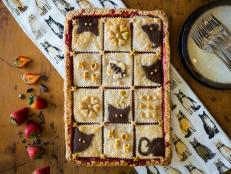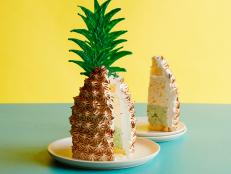What Would a Haitian Dessert Look Like Without Colonial Influence?
A classically trained pastry chef reimagines Haitian cuisine, free of European influence.

John Seaton Callahan/Getty
Once a lush nation referred to as Perle des Antilles, or the ‘Pearl of the Islands,’ Haiti has seen more than its fair share of trials throughout its history. The western side of Hispaniola was originally inhabited by the indigenous Taino until it was colonized by the French beginning in the early 17th century. For about 300 years, enslaved people were brutalized while the French took advantage of the Pearl’s natural resources and crops. In 1804, after more than a decade of revolting and fighting for freedom, Haiti became the first Black republic, the first independent Caribbean state, inspiring many revolutions and revolutionaries to come.
However, despite being the first in the region to gain independence, Haiti has long suffered — struggling to completely rid itself of colonial influences and modern imperialism.
But one part of Haitian culture that has remained just as rich and beautifully intricate over the years is its cuisine. Haitian food is distinctly vibrant and flavorful; however, its desserts are not without some outside influence. French pastries, for instance, are still deeply embedded in the country’s culture. Tropical fruits adorn French-style tarts. Gateau au beurre, or Haitian cake, is a rich butter cake similar to what you’d find in France. Though these sweets are ubiquitous in Haiti, I wouldn’t call them traditional because of their clear influence.
As a French-trained pastry chef of Haitian descent, all this made me wonder: What would Haiti’s cuisine, specifically desserts, look like without colonial influence?
So I challenged myself to reimagine what one dessert would look like without it. Here’s what I came up with.

NurPhoto/Getty
To start, I made a list of sweets that are native to Haiti — a difficult task since they play a limited role in our cuisine. There are only a handful of purely Haitian traditional pastries and desserts. There’s pain patate, a sweet potato pudding-like cake; kasav, similar to a cracker made with cassava and sometimes contains a sweet coconut filling, perfect to dip in a morning coffee; tablet, a snack of nuts boiled in sugar, usually made with peanuts or cashews, a sort of praline that is not ground down into a paste. There’s kremas, a holiday drink that has rum, condensed and coconut milk, and is spiced with star anise, cinnamon and nutmeg.
Then I asked relatives what they thought made Haitian food Haitian. Everyone emphasized that the cuisine is founded on being very mindful of the ingredients used, and embracing the long, involved processes to properly prepare them. Each ingredient serves a specific purpose, whether it be to bring a flavor, aroma or health property. Each brings something distinct to the table.
I also thought of the times my mother reprimanded me for drinking too much juice. To me juice felt like an integral part of most meals; the brightness of squeezed oranges was the perfect complement to rich breakfast eggs. It wasn’t until years later that I realized that the same juice I viewed as crucial to a good meal, was just a special treat, a dessert, to my mother.
In Haiti, juice and fresh fruit are often go-to desserts for the everyday. Papaya and soursop smoothies, guava juice, coconuts fresh from the tree — these were the sweets you could rely on regularly, growing up there. Cakes and traditional Haitian desserts are often reserved only for special occasions – birthdays and celebrations, or to welcome guests.

Photo courtesy of Brigitte Malivert
With all this in mind, I ultimately decided to riff on labouyi, a childhood favorite of mine, by turning the common Haitian breakfast dish into a luxurious dessert. I played with the purpose of ingredients, infused aromas and incorporated flavors that are new to the dish, but close to the land.
Labouyi has long been part of Haitian cuisine — a safe food to make when your child is a picky eater. Typically, it’s a light porridge that can be made with bulgur wheat, cornmeal or plantain puree and is served as is without the addition of much else. As a kid, I would request it for almost every meal. Whenever my request was honored, I savored every bite, eating the bowl in a spiral from the outside in (a useful trick if you cannot wait for it to cool).
Initially I entertained writing a recipe for a labouyi tart – a tart filled with the porridge – but realized, with my challenge parameters, a tart shell would be a no-go. Tarts have origins in Europe – one of the first works to offer a recipe for a butter-layered tart crust is Lancelot de Casteau’s Ouverture de cuisine, a known European cookbook published in 1604.
I then thought of making a cake layered with the porridge and a crunchy element. But I ended up turning away from this direction as I realized I would have just been building an entremet, which is no different than the tropical entremets – layered desserts that include fluffy sponge cake and tropical fruit puree layers – you can find in Paris.
So I circled back to the ingredients I wanted to showcase: cornmeal and cassava, two “pre-contact” Taino culinary staples, and imagined what the absolute first dessert would look like. I workshopped my usual recipe of labouyi, and decided to smoke the porridge in a banana leaf over a charcoal grill, so that the flavor of the leaf would infuse into the final product, while also borrowing from a traditional cooking method sometimes used to make Haitian street foods.
I then worked backwards to recreate the flavors that lived in my nostalgia — the richness of the cornmeal cooked in milk, and the comforting undernotes of star anise and nutmeg. I added cassava flour to boost creaminess, plus copious amounts of lime zest to brighten the whole bowl. Then, fresh slices of guava to starkly interrupt the richness of the dish, so you’re left feeling light though satisfied.
Although simple, the porridge is indulgent. The char gives the porridge the earthy depth of the banana leaf when it first hits your tongue, but then dissipates, leaving each ingredient enough room to shine.
Cassava, fresh fruit and smoking the porridge in a banana leaf are not traditional to the dish. But labouyi’s beauty lies in its versatility. I believe my new version of the porridge, made creamier with the Taino staple, and bejeweled with an everyday Haitian sweet, cooked over an open flame, would best fulfill the quest to create a perfectly reimagined dessert that pays homage to pre-colonial Haiti.
Each component of this dish reminds me of my childhood and the days I spent in the island’s lush gardens. In my Labouyi nan fey Bannann, I hope you taste sunshine.
Related Content:


































